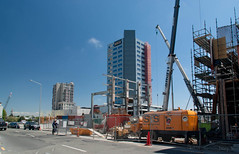
Search
Images for Christchurch Earthquake, N.Z., 2011; more images...
X Marks the Spot
Images, eqnz.chch.2010
What I found on a walk around the city Christchurch November 20, 2013 New Zealand. www.isaactheatreroyal.co.nz/ en.wikipedia.org/wiki/2011_Christchurch_earthquake
Gap filler Fair at Addington
Images, eqnz.chch.2010
Photos taken at Gap Filler fair on April 9 following the February 22 earthquake. www.gapfiller.org.nz/ File reference: CCL-2011-04-08-Addington-Gapfiller-003.jpg From the collection of Christchurch City Libraries
Gap filler Fair at Addington
Images, eqnz.chch.2010
Photos taken at Gap Filler fair on April 9 following the February 22 earthquake. www.gapfiller.org.nz/ File reference: CCL-2011-04-08-Addington-Gapfiller-005.jpg From the collection of Christchurch City Libraries
Gap filler Fair at Addington
Images, eqnz.chch.2010
Photos taken at Gap Filler fair on April 9 following the February 22 earthquake. www.gapfiller.org.nz/ File reference: CCL-2011-04-08-Addington-Gapfiller-007.jpg From the collection of Christchurch City Libraries
Gap filler Fair at Addington
Images, eqnz.chch.2010
Photos taken at Gap Filler fair on April 9 following the February 22 earthquake. www.gapfiller.org.nz/ File reference: CCL-2011-04-08-Addington-Gapfiller-002.jpg From the collection of Christchurch City Libraries
Gap filler Fair at Addington
Images, eqnz.chch.2010
Photos taken at Gap Filler fair on April 9 following the February 22 earthquake. www.gapfiller.org.nz/ File reference: CCL-2011-04-08-Addington-Gapfiller-004.jpg From the collection of Christchurch City Libraries
Gap filler Fair at Addington
Images, eqnz.chch.2010
Photos taken at Gap Filler fair on April 9 following the February 22 earthquake. www.gapfiller.org.nz/ File reference: CCL-2011-04-08-Addington-Gapfiller-008.jpg From the collection of Christchurch City Libraries
Gap filler Fair at Addington
Images, eqnz.chch.2010
Photos taken at Gap Filler fair on April 9 following the February 22 earthquake. www.gapfiller.org.nz/ File reference: CCL-2011-04-08-Addington-Gapfiller-001.jpg From the collection of Christchurch City Libraries
Gap filler Fair at Addington
Images, eqnz.chch.2010
Photos taken at Gap Filler fair on April 9 following the February 22 earthquake. www.gapfiller.org.nz/ File reference: CCL-2011-04-08-Addington-Gapfiller-006.jpg From the collection of Christchurch City Libraries
Rebuilding Christchurch: Amended Building Codes and their Impacts in NZ
Research papers, University of Canterbury Library
The level of destruction from the 2011 Christchurch earthquakes led to changes in the New Zealand seismic building code. The destruction showed that the NZ building codes did not fully performed to expectation and needed Improvement to ensure that impact of future earthquakes would be minimised. The building codes have been amended to improve buildings resilience to earthquake and other related extreme loading conditions. Rebuilding Christchurch with the new modifications in the seismic building code comes with its own unique challenges to the entire system. This project investigates the impact of rebuilding Christchurch with the new seismic Building codes in terms of how the new changes affected the building industry and the management of construction.
WEMO ERT Set 1 - March 2011 - Photograph 16
Images, UC QuakeStudies
A photograph of members of the New Zealand Police using a rescue dog to inspect an earthquake-damaged house in Christchurch. The front and side of the house has collapsed, the bricks and other rubble spilling onto the garden, exposing the rooms inside.
Jim Baltaxe WEMO Photograph 037
Images, UC QuakeStudies
A photograph of a member of the New Zealand Army on the roof of an earthquake-damaged property in Christchurch. A tarpaulin has been placed over a hole in the roof caused by the collapsed chimney.
Energy - Communication Resilience
Research papers, University of Canterbury Library
This is a joint Resilience Framework undertaken by the Electrical, Computer and Software Engineering Department of the University of Auckland in association with West Power and Orion networks and partially funded by the New Zealand National Science Challenge and QuakeCoRE. The Energy- Communication research group nearly accomplished two different researches focusing on both asset resilience and system resilience. Asset resilience research which covers underground cables system in Christchurch region is entitled “2010-2011 Canterbury Earthquake Sequence Impact on 11KV Underground Cables” and system resilience research which covers electricity distribution and communication system in West Coast region is entitled “NZ Electricity Distribution Network Resilience Assessment and Restoration Models following Major Natural Disturbance“. As the fourth milestone of the aforementioned research project, the latest outcome of both projects has been socialised with the stakeholders during the Cigre NZ 2019 Forum.
- 1



